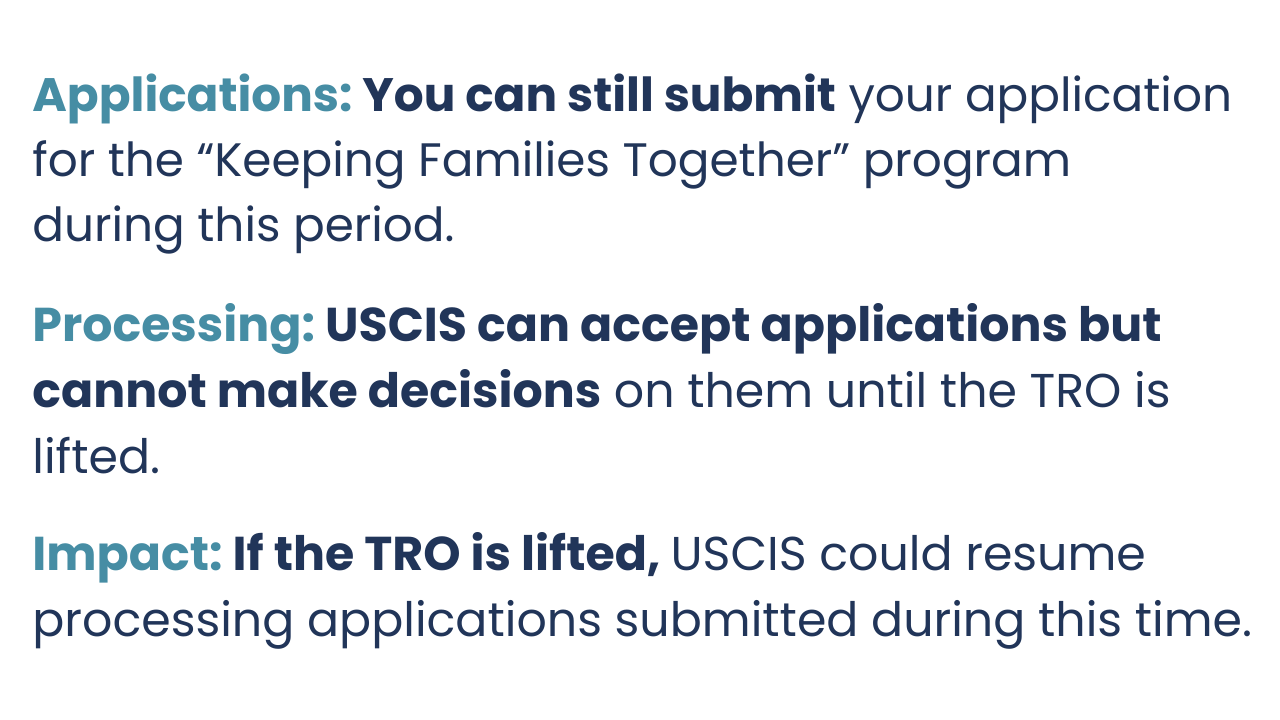We’re excited to share some great news! The U.S. Citizenship and Immigration Services (USCIS) has published new information about the Parole in Place application process. This PIP procedure applies to Biden’s Parole in Place announced on June 18, 2024.
The new Parole in Place application process applies to undocumented spouses and stepchildren of U.S. citizens. It’s all part of the “Keeping Families Together” program. You can now begin applying online using a new form called Form I-131F as of today, August 19, 2024. This form will only be available online and can’t be mailed in.
We will continue to provide more details on Biden’s PIP procedure as soon as it becomes available in the Federal Register. Keep reading and get the latest tips and information you need to secure your family’s future in the United States!
TEMPORARY RESTRAINING ORDER (TRO) IS IN EFFECT FOR 14 DAYS

Parole in Place Application Process Explained
USCIS has released a Filing Guide for Form I-131F on their Keeping Families Together webpage to help you prepare for the Parole in Place application process.
This guide offers helpful tips and information about what to expect while completing the Parole in Place application process and forms online.
You’ll also need to create a USCIS online account and collect some specific information before you start your application. The How to Create a USCIS Online Account and the Tips for Filing Forms Online pages will help you get started.
Parole in Place Application Process: Get These Items Ready
- Share your full name and any other names you've gone by.
- Provide your current mailing and physical address(if it's different).
- Your phone number and email address.
Parole in Place Application Process: Are You Eligible?
You’ll need to meet certain requirements about where you are in the U.S., your relationship with a U.S. citizen, and your criminal history to qualify for Parole in Place. We’ve made the Parole in Place application process easy to understand below.
This will help you see if you meet the criteria and what steps to take next. Remember, if you entered the U.S. with a valid visa, you can't get parole in place, even if you stayed past your visa's expiration date.
You Can Ask for Parole in Place If
- Are in the U.S. without official entry or parole.
- Have been living in the U.S. continuously:
- Since at least June 17, 2014, if you’re applying as a spouse.
- As of June 17, 2024, if you’re applying as a stepchild.
You Also Need To
- If you're applying as a spouse, be married legally to a United States citizen as of June 17, 2024
- If you're applying as a stepchild, your parent must have married a U.S. citizen by June 17, 2024, and before you turned 18.
You Must Also
- Have no serious criminal history.
- Not be a threat to national security or public safety.
What Documents Do You Need?
You’ll need to provide important documents to complete the Parole in Place application process. Documents include proof of your relative’s U.S. citizenship, evidence of your relationship to them, and proof that you’ve been living in the U.S. Here’s what you need to know about gathering these documents for your application.
Required Documents for the I-131F Online Parole Application
You need to gather some documents for the I-131F online Parole in Place application. Start collecting these documents as soon as you can.
Photo Identity Document
You’ll need to upload a copy of a document with your photo, name, and date of birth. Expired identity documents are also acceptable.
Some Parole in Place Place Application Process Options
- A valid government-issued driver’s license.
- A passport identity page.
- A national identity document from your home country with your photo.
- A school ID with your photo.
- Any other official document with your photo.
Proof of Your Relative’s U.S. Citizenship
You need to show that your spouse or stepparent is a U.S. citizen. You can do this by uploading a copy of one of these documents. If the document is in a foreign language you must include an English version,
- U.S. birth certificate.
- Certificate of United States Naturalization.
- Certificate of United States Citizenship.
- Birth Abroad Consular Report.
- U.S. passport.
Proof of Your Relationship
You must also show that you are the spouse or stepchild of the U.S. citizen. Upload evidence such as:
- Marriage Certificate.
- Proof of any previous marriages that ended (if applicable).
- Birth certificate showing your noncitizen parent’s name (if you are a stepchild).
- Include your United States citizen spouse’s Death certificate, your United States citizen stepparent’s Death Cerificate, or your noncitizen parent’s Death Certificate (if applicable).

Proof of Continuous Presence in the U.S.
You need to show that you have been living in the U.S. continuously when you complete the Parole in Place application process. You need to provide enough evidence to show you have been continuously present in the U.S. for the required period.
Please note, you don’t need to submit proof for every single day, week, or month. USCIS will review all the evidence to decide if you meet the requirements.
You can provide the following during the Parole in Place application process:
- Immigration or DHS documents stating your date of entry (like Form I-862, Notice to Appear)
- Rent receipts, utility bills, or letters from companies showing dates of service (even if they are in your parents' or guardians' names, as long as you provide other proof of your presence).
- Tax returns, tax transcripts, or tax receipts.
- School records (like transcripts or report cards) from schools you have attended in the U.S.
- Hospital or medical records showing treatment or hospitalization dates.
- Records from religious organizations in the U.S. confirming your participation in religious ceremonies (like baptisms or weddings).
- Statements from religious groups, unions, or other organizations confirming you were there.
- Or other documents like money order receipts, birth certificates of children born in the U.S., dated bank records, correspondence, car license receipts, deeds, rental agreements, contracts, insurance policies, or postmarked letters.
Parole in Place Application Process: Important Notices
It’s a good idea to talk to an experienced Parole in Place immigration lawyer near you if you find yourself in the following situations.
Important Notice for Widows and Widowers of U.S. Citizens
If your U.S. citizen spouse or stepparent has passed away before you submitted your parole request, you might still qualify for Parole in Place. You’re eligible as a noncitizen spouse if your marriage to a deceased U.S. citizen happened on or before June 17, 2024. You also qualify if you’re a noncitizen stepchild of a deceased U.S. citizen.
Criminal Record Declarations
If you’ve been arrested or charged with a crime, either in the U.S. or another country, you must upload proof of what happened with those charges.

Important Benefits
If you get parole through the Parole in Place application process, it will last for 3 years from when it’s approved. You can stay in the U.S. legally and apply for a green card (lawful permanent residency) by filling out Form I-485 with USCIS while your PIP is valid.
You can also apply for an Employment Authorization Document (EAD) right away. You can submit Form I-765 with the (c)(11) category code to complete the process.
Parole Place Application Process: Important Requirements
Make sure you are aware of the filing fee, document requirements, and steps involved in the Parole in Place application process. This guide will walk you through what you need to do to successfully submit your application and what to expect once you’re approved.
Completing the Parole in Place Application Process
Starting August 19, 2024, you can only file the I-131F Application for Parole in Place online through the USCIS website. USCIS will only accept online applications.
Filing Fee
The filing fee for Form I-131F is $580. USCIS will not accept any waivers or free exemptions during the Parole in Place application process.
Separate Parole in Place Applications Required
Each person applying, including minors, must file their own Form I-131F and create their own USCIS online account to complete and submit the application.
Parole in Place Application Process Document Requirements
As you fill out the online application, the USCIS system will tell you which documents you need to provide.
Biometrics Appointment
After you submit your application, you will need to attend a biometrics appointment for USCIS to collect your biometrics information for screening.
Receiving Form I-94
If USCIS approves your Form I-131F, you will receive a Form I-94 Arrival/Departure Record, which shows that you have been granted parole.
Important Note on Travel
The Form I-94 does not allow you to re-enter the U.S. You might not be able to return, and your parole will end automatically if you leave the U.S. without an Advance Parole Document from USCIS.
Providing False Information is a Serious Violation
USCIS wants to remind you that giving false information on the I-131F form while completing the Parole in Place application process is a serious violation of immigration law.
Revocation of Parole in Place
If you provide false information or hide important details on your I-131F application, USCIS may revoke your parole in place. The Department of Homeland Security (DHS) can also end your parole at any time if they decide your continued presence in the U.S. is not needed. Receiving a Notice to Appear (NTA) for removal proceedings after your parole is granted means your parole will be canceled.
Consequences of Falsifying Information
If you knowingly lie, hide facts, or submit fake documents with your Form I-131F, USCIS will deny your Parole in Place application. USCIS may also deny other immigration benefits and you could face criminal charges.
Start Your Parole in Place Application Process Today!
Now that you know all about the new Parole in Place application process, it’s time to take action to ensure you and your family can become eligible for Parole in Place benefits. Gather your documents, set up your USCIS online account, and start your application using Form I-131F.
Don’t hesitate to reach out to our Parole in Place immigration experts if you have any questions or need help. The sooner you begin, the closer you’ll be to securing your family’s future!
Posted in: Blog

